
AMD is kick starting the new FX lineup with seven processors, including 8-, 6- and 4-core models. The flagship processor is the FX-8150, which features a base frequency of 3.6GHz with a Turbo Core clock of 3.9GHz and a Max Turbo speed of 4.2GHz. Before delving any deeper, let us explain what the Turbo Core and Max Turbo frequencies mean.
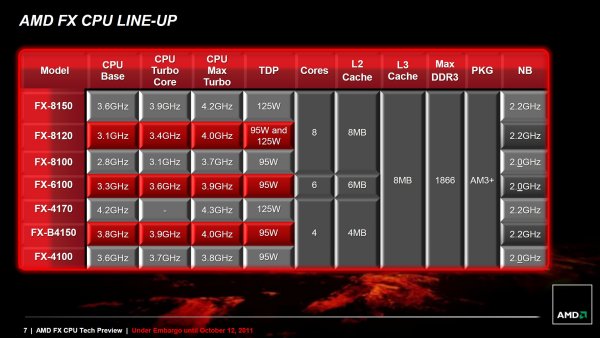
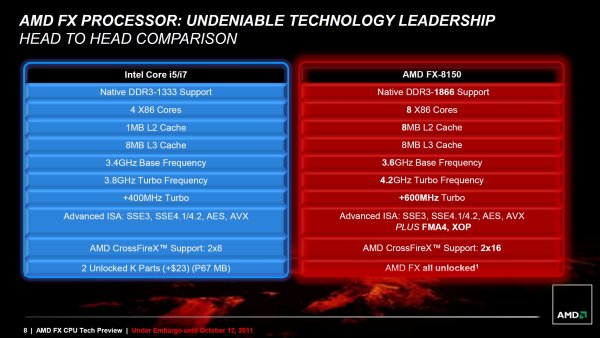
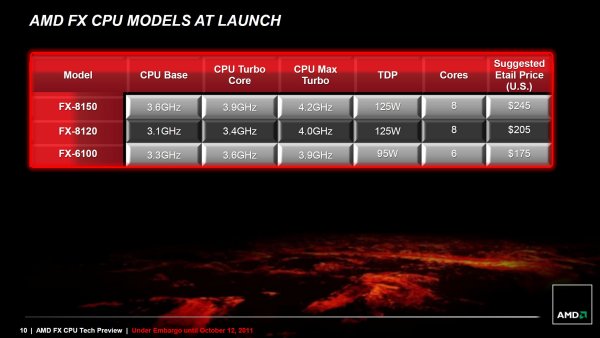
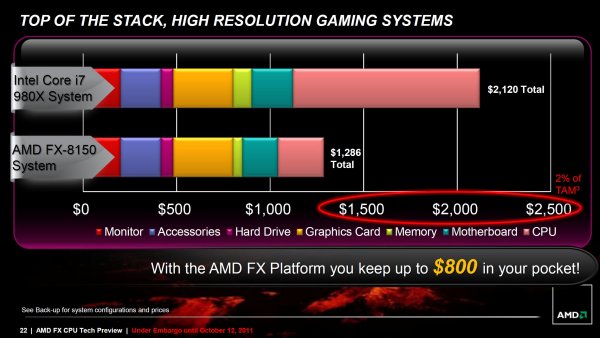
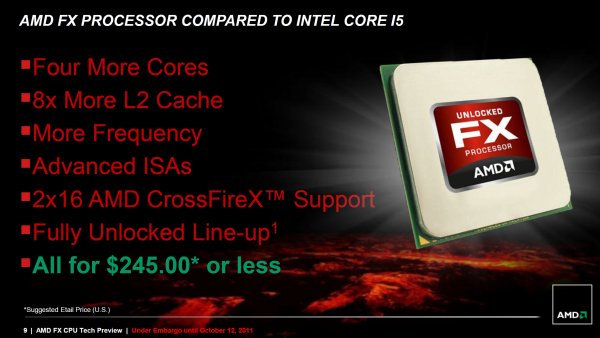
Lastly, there are three 4-core models: the FX-4170, FX-B4150 and FX-4100. All of the quad-core CPUs have 4MB L2 cache with 8MB L3 cache. The FX-4170 is the highest clocked Bulldozer chip with a standard frequency of 4.2GHz, however, Turbo Core is disabled and the Max Turbo frequency is just 100MHz above the base clock.
AMD’s new microarchitecture is designed to provide the perfect balance between performance, cost and power consumption for multithreaded applications. It focuses on high frequencies and resource sharing to achieve optimal throughput. As mentioned previously, the AMD FX processors offer up to eight power-efficient cores. These represent the first generation of a new execution-core family (15h) from AMD.
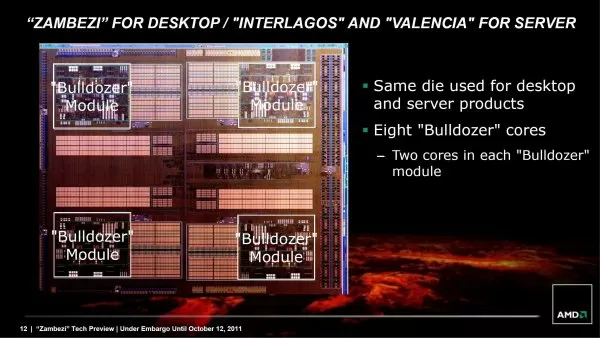
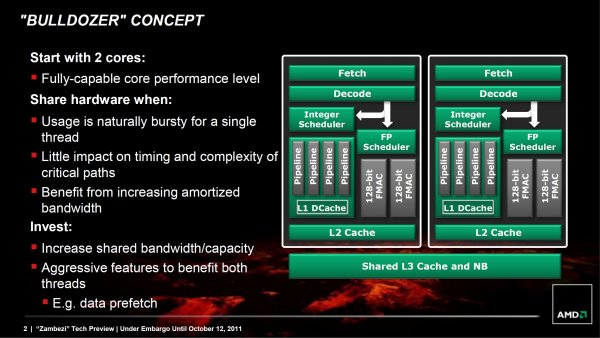
The Zambezi Bulldozer-based processors have a die size of 315mm², which is smaller than the Phenom II x6’s 346mm² die, while it’s bigger than the Phenom II X4’s 258mm² die. The 6-core “Gulftown” Intel Core i7 processors are also smaller at 240mm2, and the complex Sandy Bridge chips such as the i7-2600K are 216 mm².
A large 32nm die means a lot of resistors and AMD tells us that the Zambezi architecture has roughly two billion of them. That’s pretty incredible given the Intel Core i7-990X Gulftown (32nm) features 1.17 billion while the Core i7-2600K has just 995 million. The older Phenom II X6 processors have 904 million and the Phenom II X4 chips just 758 million. Those numbers help convey just how complex these Bulldozer CPUs really are.

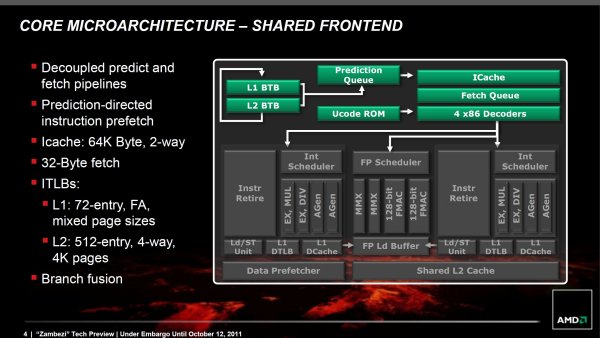
A Prediction Queue can manage direct and indirect branches that are now fed with a L1 and L2 Branch Target Buffer, which stores destination addresses. The Bulldozer modules can decode up to four instructions per cycle, which is one more than the Phenom II processors. The prediction pipeline produces a sequence of fetch addresses. The Fetch pipeline performs a look up in the instruction cache and pulls 32 bytes per cycle into the fetch queue to feed the decoders.
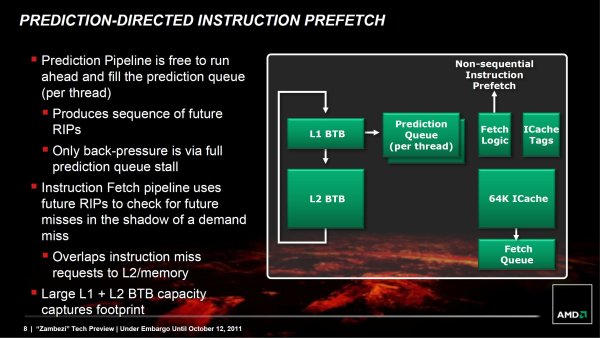
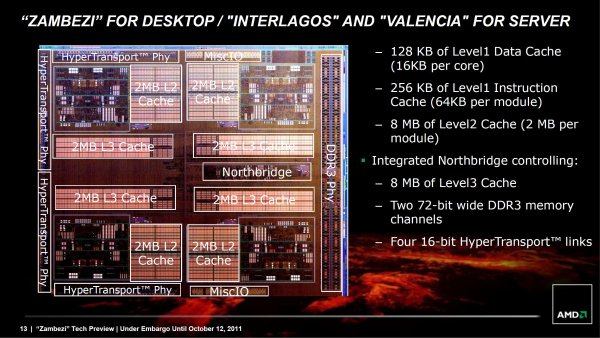
The northbridge is also separate from the processor. Even though AMD claims to include an integrated northbridge, it’s really just a memory controller. In fact, AMD pioneered this technology back in the Athlon64 days. Bulldozer’s northbridge features two 72-bit wide DDR3 memory channels and four 16-bit receive/16-bit transmit HyperTransport links.
As mentioned on the previous page, AMD is sticking with a north and southbridge chipset design for the AM3+ platform and this makes sense in our opinion, particularly for such a high-end platform. By including separate chips to handle PCI Express lanes and connectivity, AMD has not only been able to simplify the processor design, allowing it to focus on performance, but it also grants the company a great deal of flexibility.
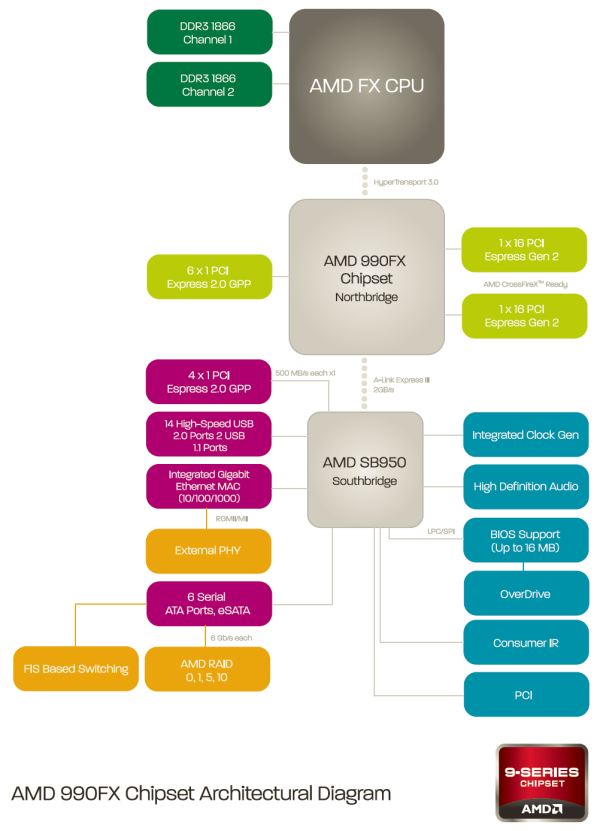
In fact, the SB950 and SB850 are the same chip and therefore offer the exact same features. The reason for the name change is simply to help the user identify that one is designed for the AM3+ platform while the other supports AM3 processors.
The SB950 southbridge supports six SATA 6Gb/s ports with AHCI 1.2 as well as RAID 0, 1, 5 and 10. Additionally there is support for 14 USB 2.0 ports along with two USB 1.1 ports and gigabit Ethernet. When compared to the Intel Z68 PCH (Platform Controller Hub), there is nothing missing from the SB950 southbridge.
Meanwhile, the 990FX (codenamed RD990) is essentially the same chip as the 890FX, though there is one minor change. The 990FX has been updated with HyperTransport 3.1 to support up to 51.2GB/s bandwidth between it and the CPU. The 890FX is equipped with HT 3.0 which features a bandwidth of 41.6GB/s.
The 990X is a cut down version of the 990FX, as it reduces Crossfire support from dual x16 or quad x8 lanes to a pair of x8 lanes with no quad-fire support. Continuing with the theme, AMD’s 970 chipset is basically a rebadged 870 with HT 3.1 support added. It lacks Crossfire support as it only includes a single PCIe 2.0 x16 lane.
AMD 990FX boards have been on the loose for some time now — we’ve had the Asrock Fatal1ty 990FX Professional for about two months. Along with its Fatal1ty- branded board, Asrock offers two other 990FX-based motherboards: the 990FX Extreme4 and 990FX Extreme3. The company also has a couple of AMD 970 motherboards available.The Fatal1ty 990FX Professional is currently retailing for $190, which is very affordable for a high-end motherboard. The price is especially impressive considering the included features, such as USB 3.0, SATA 6Gb/s, 8-channel audio, dual Gigabit LAN with Teaming function, 12 + 2 power phase design as well as Quad Crossfire and SLI support.


Features such as USB 3.0 remain the same, while the Crosshair V Formula drops one of the two gigabit Ethernet jacks and eSATA ports. The audio has been upgraded to the SupremeFX X-Fi 2 codec, while the board also features an extra full-length PCIe 2.0 x16 slot. Overall, we prefer Asus’ aesthetics, but its board about equal in terms of functional design.

Although we’ve only received boards from Asrock and Asus so far, other manufacturers such as MSI and Gigabyte already have their flagship 990FX boards in stores, including the $145 MSI 990FXA-GD65 and $250 Gigabyte GA-990FXA-UD7.
– AMD Phenom II X6 1100T (3.30GHz)
– AMD Phenom II X4 980 (3.70GHz)
– AMD FX-8150 (3.60GHz)
– AMD FX-8120 (3.10GHz)
– AMD FX-6100 (3.30GHz)
– AMD FX-4170 (4.20GHz)
– x2 4GB G.Skill DDR3 PC3-12800 (CAS 8-8-8-20)
– Asrock Fatal1ty 990FX Professional (AMD 990FX)
– OCZ ZX Series 1250w
– Crucial m4 256GB (SATA 6Gb/s)
– Gigabyte GeForce GTX 580 SOC (1536MB)
Software
– Microsoft Windows 7 Ultimate SP1 64-bit
– Nvidia Forceware 285.38Intel LGA1155 Test System Specs
– Intel Core i7-2600K
– Intel Core i5-2500K
– x2 4GB G.Skill DDR3 PC3-12800 (CAS 8-8-8-20)
– Gigabyte G1.Sniper2 (Intel Z68)
– OCZ ZX Series 1250w
– Crucial m4 256GB (SATA 6Gb/s)
– Gigabyte GeForce GTX 580 SOC (1536MB)
– Microsoft Windows 7 Ultimate SP1 64-bit
– Nvidia Forceware 285.38Intel LGA1366 Test System Specs
– Intel Core i7-975 Extreme Edition (3.33GHz)
– Intel Core i7-920 (2.66GHz)
– x3 2GB G.Skill DDR3 PC3-12800 (CAS 8-8-8-20)
– Gigabyte G1.Sniper (Intel X58)
– OCZ ZX Series 1250w
– Crucial m4 256GB (SATA 6Gb/s)
– Gigabyte GeForce GTX 580 SOC (1536MB)
Software
– Microsoft Windows 7 Ultimate SP1 64-bit
– Nvidia Forceware 285.38Intel LGA1156 Test System Specs
– Intel Core i5-750
– x2 4GB G.Skill DDR3 PC3-12800 (CAS 8-8-8-20)
– Gigabyte P55A-UD7 (Intel P55)
– OCZ ZX Series 1250w
– Crucial m4 256GB (SATA 6Gb/s)
– Gigabyte GeForce GTX 580 SOC (1536MB)
– Microsoft Windows 7 Ultimate SP1 64-bit
– Nvidia Forceware 285.38
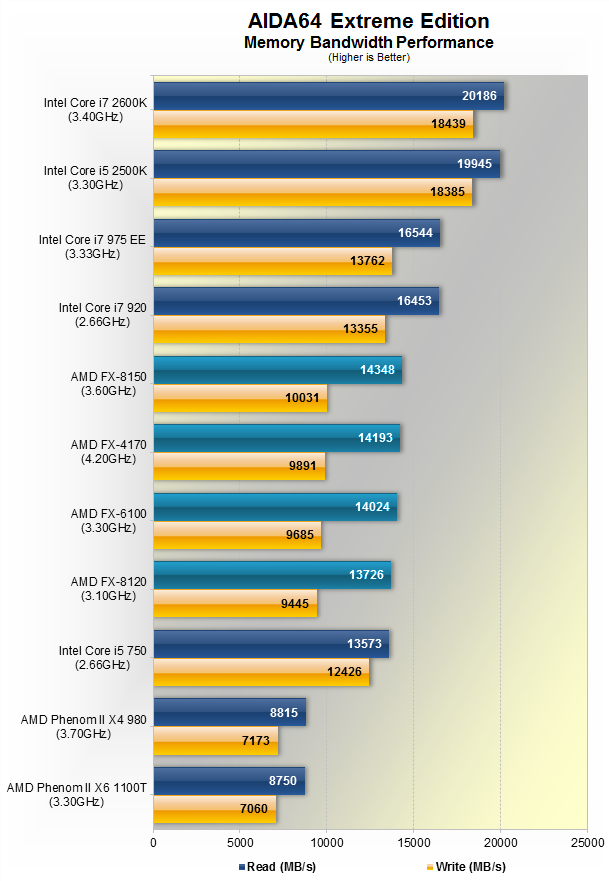
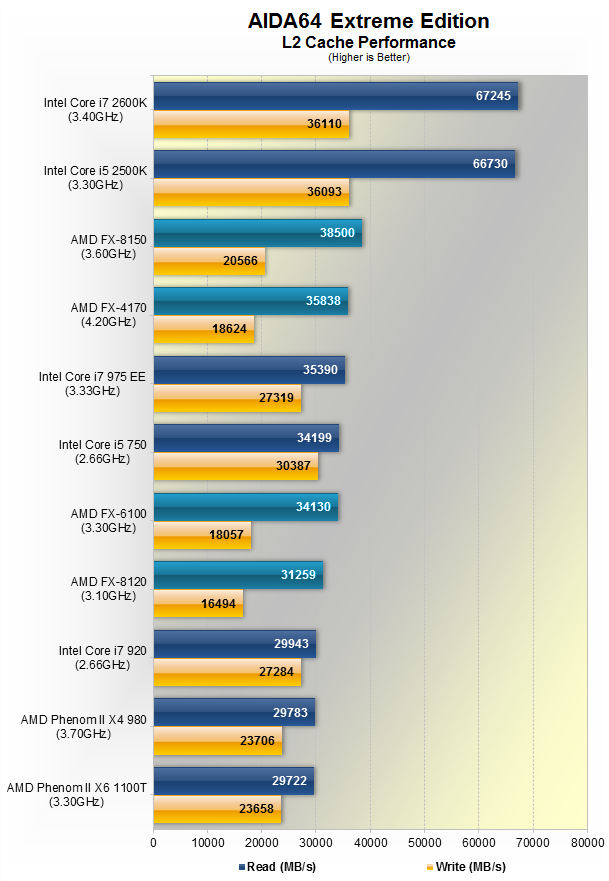

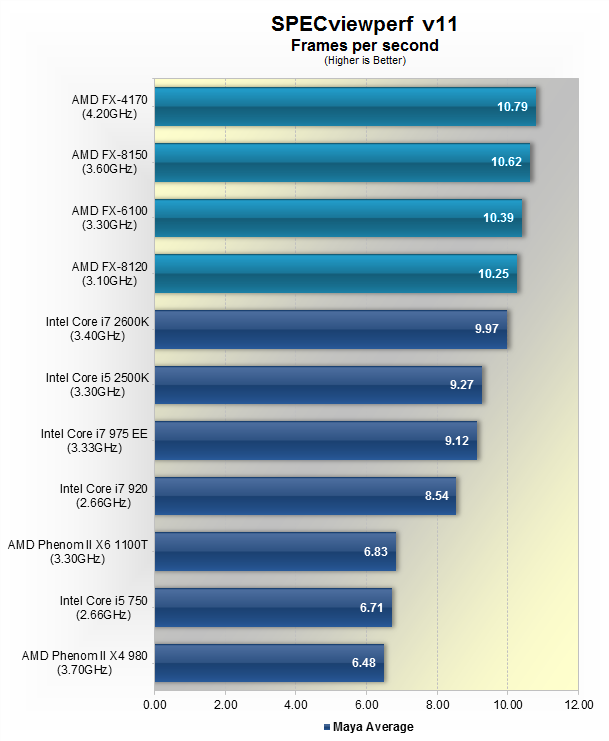
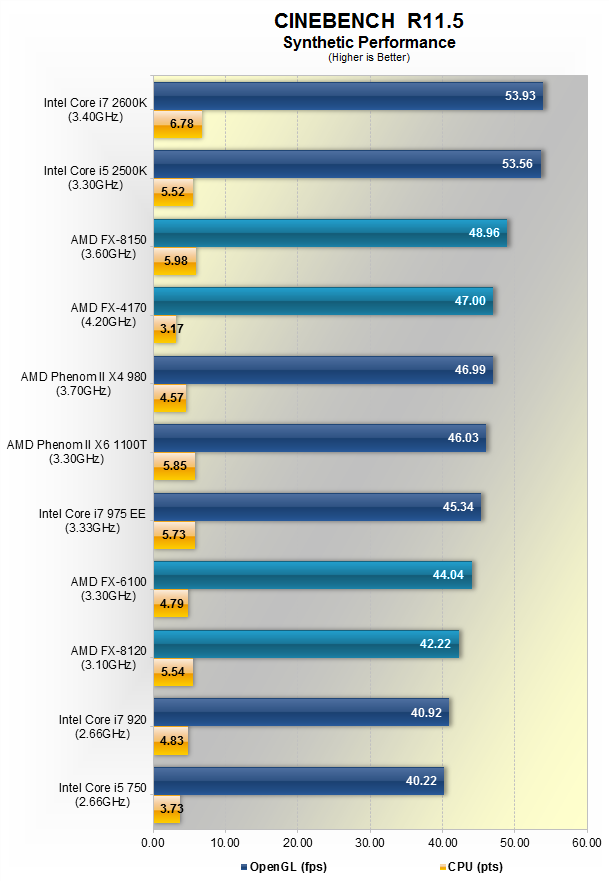
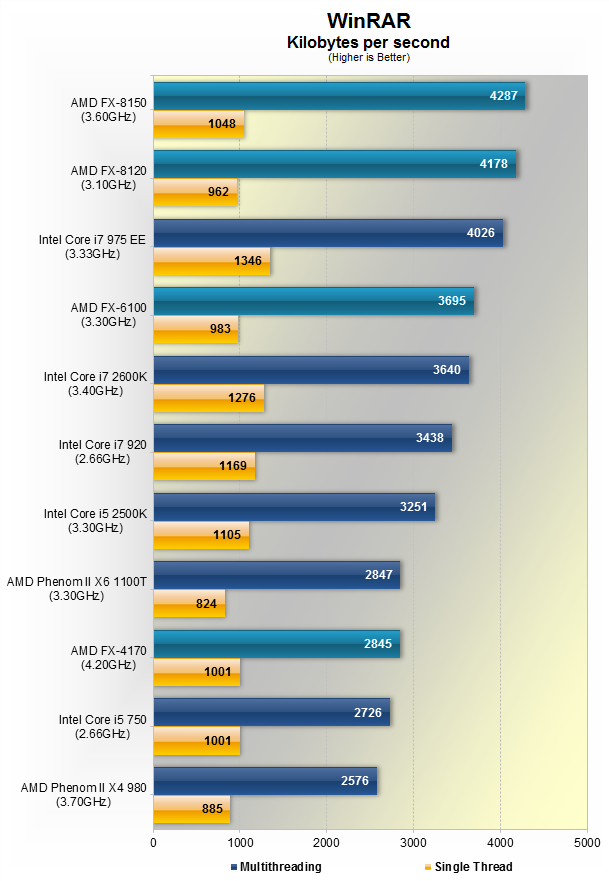
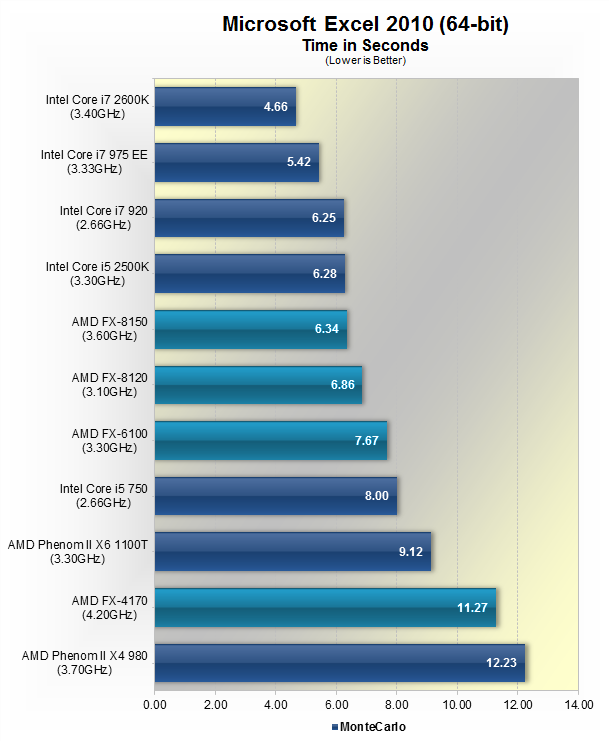
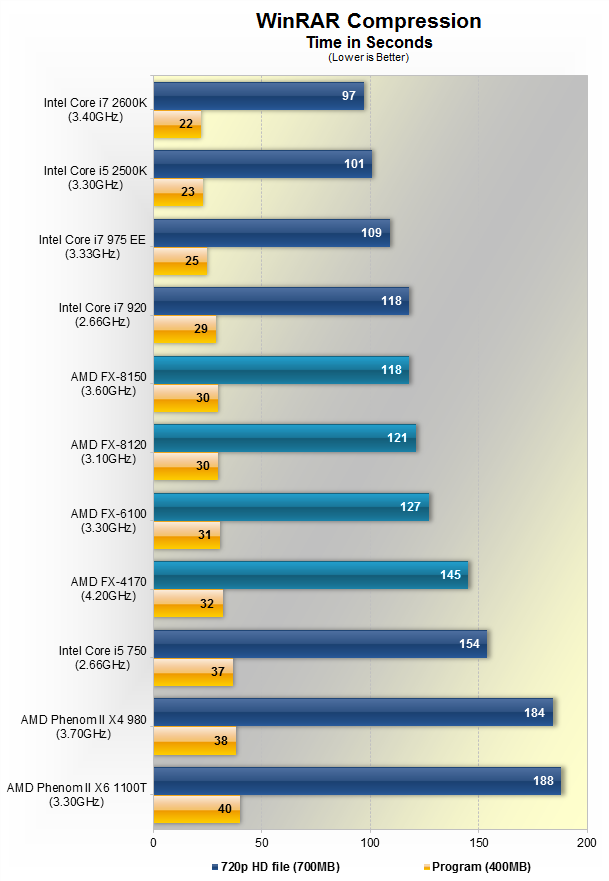
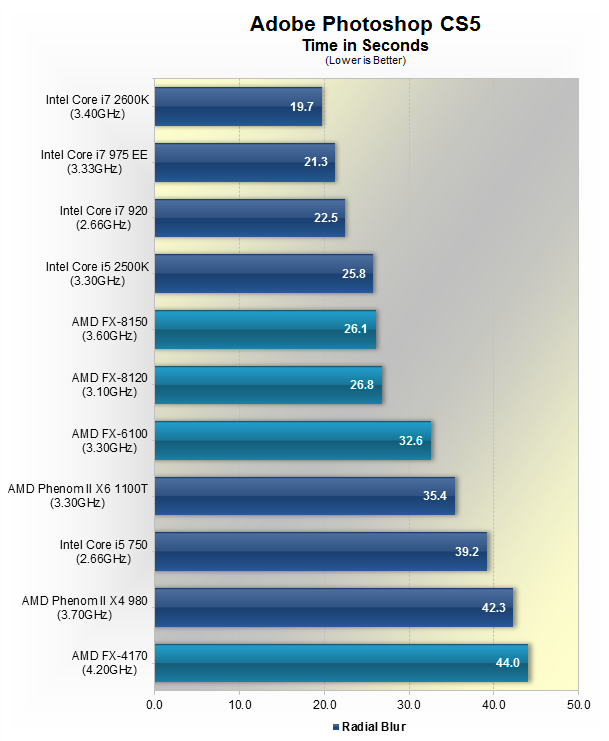
The FX-8120 was only a fraction of a second slower than its snappier sibling, and although the FX-6100 saw a noticeable performance drop, it was still 8% faster than the Phenom II X6 1100T. Oddly. the FX-4170 was 4% slower than the Phenom II X4 980, which is surprising considering they’re both quad-core processors and the FX-4170 has a significant clock advantage.
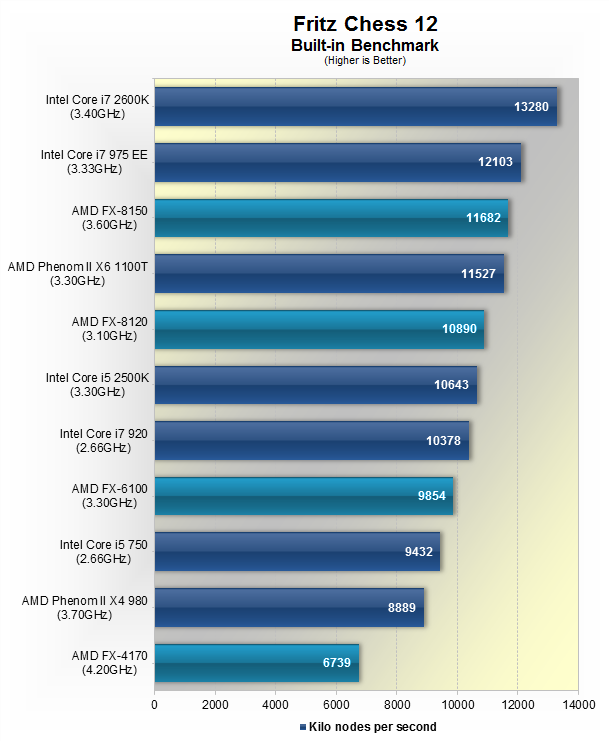
Clock for clock, the FX processors are likely no faster than the Phenom II in this test, as the FX-8120 was 6% slower than the Phenom II X6 1100T. Moreover, the FX-4170 was 24% slower than the Phenom II X4 980 despite having a 14% higher frequency.
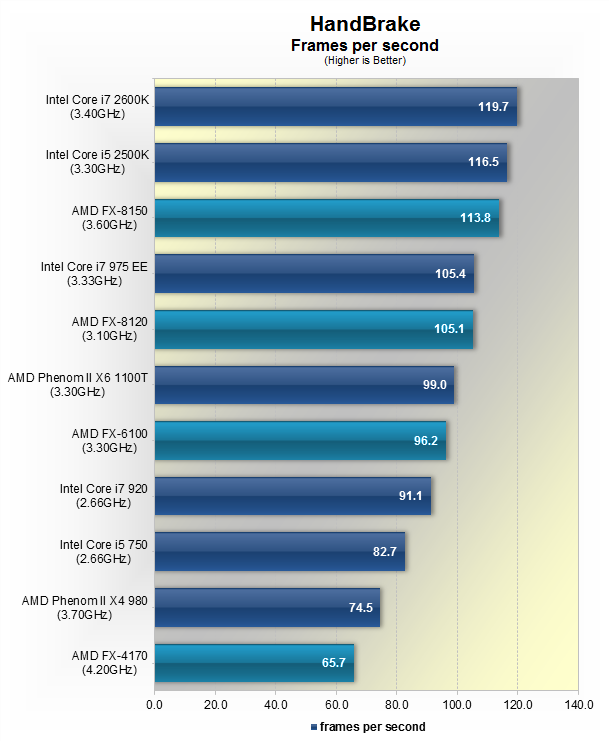
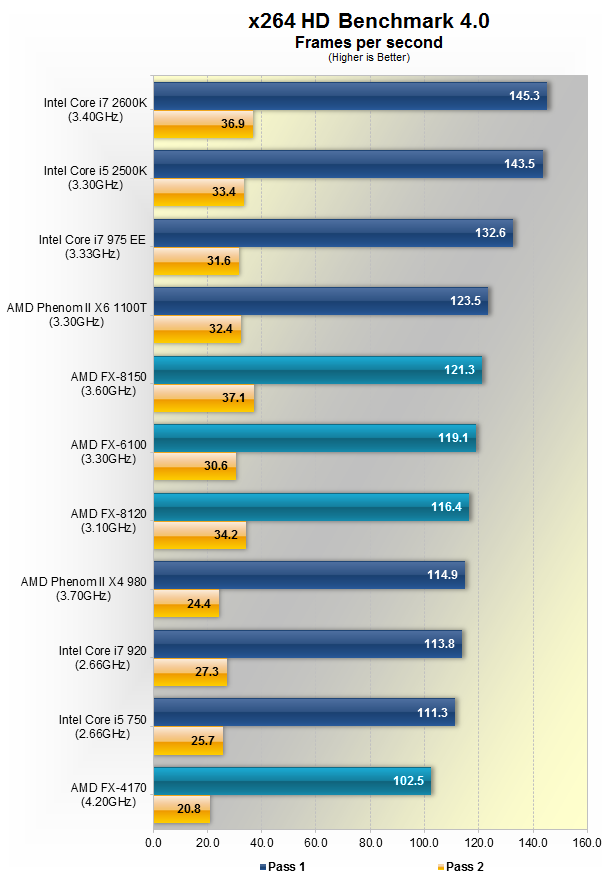
Things were quite different in the Pass 2 test, as the FX-8150 scored the best with 37.1fps, beating the i7-2600K by half a percent. The FX-6100 and FX-4170 still lagged behind their Phenom II counterparts.
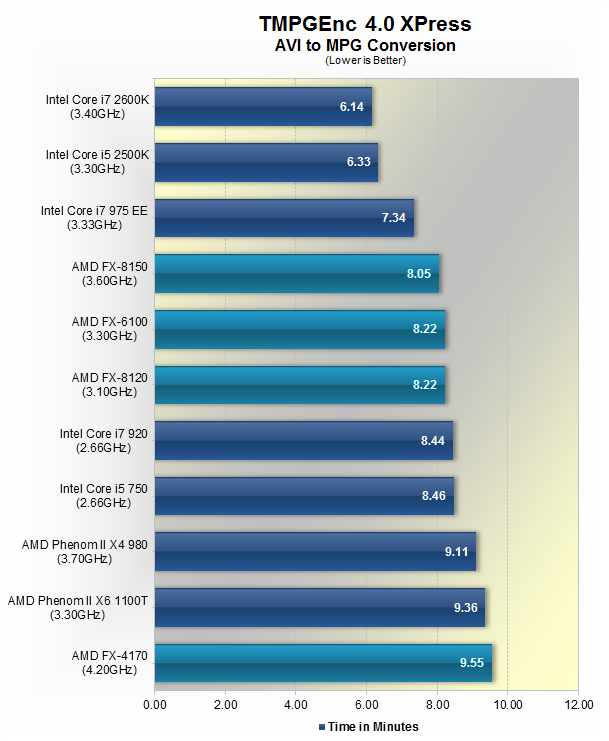


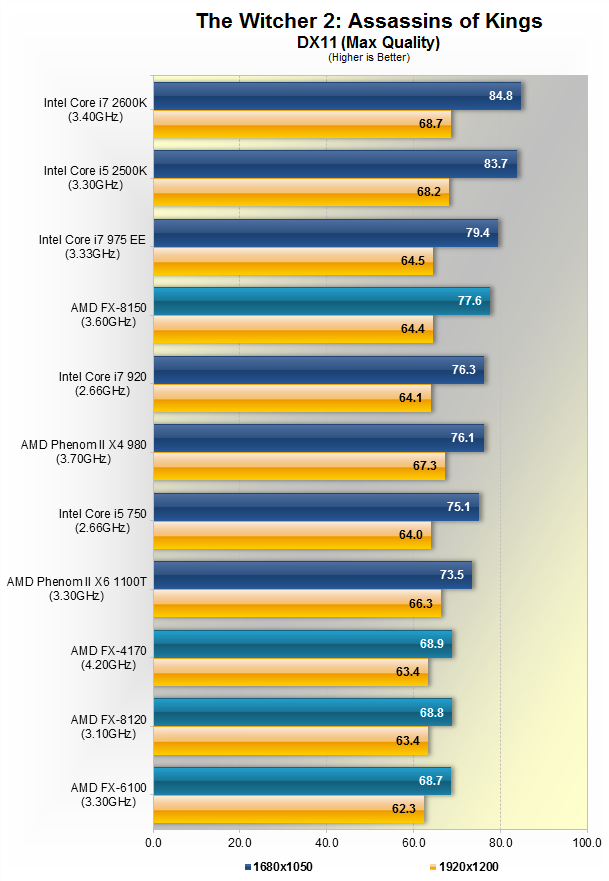
The FX-8150 delivered roughly 1fps more than the FX-8120 and FX-6100 when testing at 1920×1200, and although that’s in line with the i7-975 EE and 920, it was slower than the Phenom II X4 980 and X6 1100T.
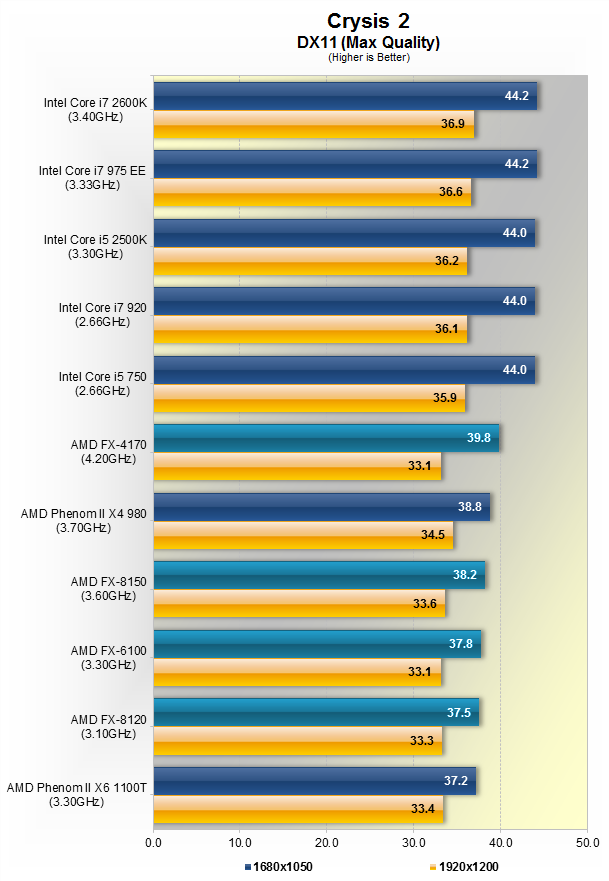

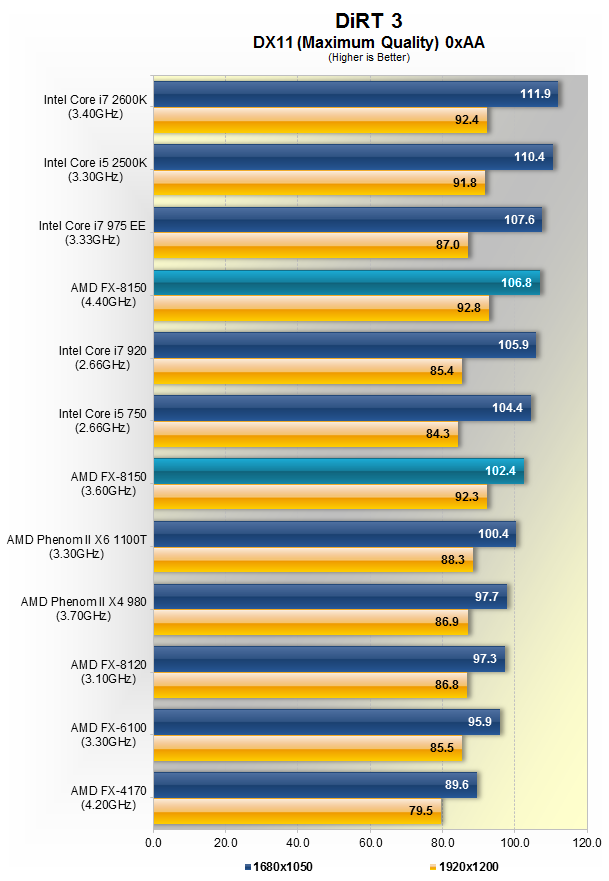

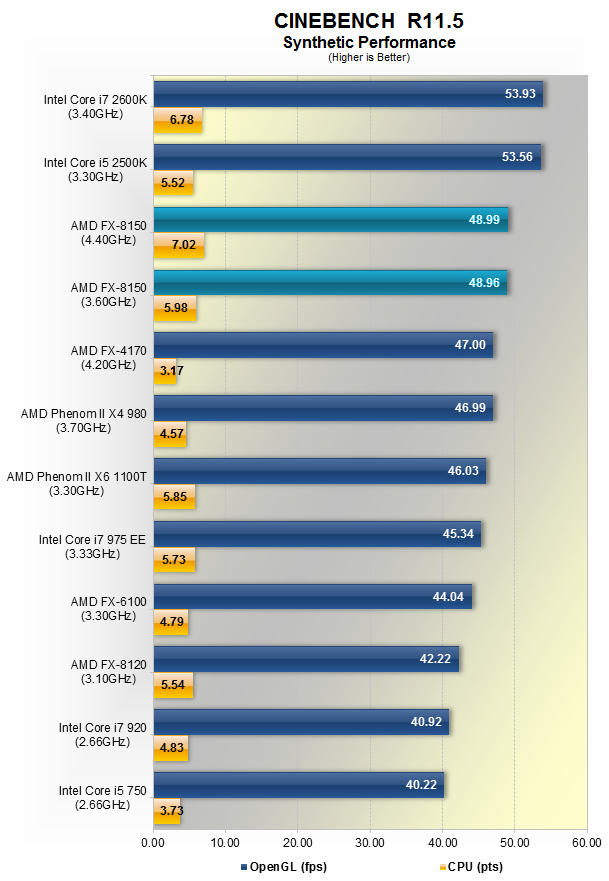
Breaking down our benchmark results we find that the AMD FX-8150 offers huge performance improvements over the Phenom II range when testing with Excel 2010, while it matched the Core i5-2500K and Core i7 920 processors. Our custom WinRAR benchmark also heavily favored the FX-8150 over the Phenom II, matched the Core i7 920 and trailed behind Sandy Bridge processors in this test.
The Adobe Photoshop CS5 benchmark also saw the FX processors provide decent performance gains over the Phenom II. Although the six-core FX-6100 was only slightly faster than the Phenom II X6 1100T, the eight core FX-8150 and FX-8120 processors provided significant gains and were able to match the Core i5-2500K.
The encoding performance was far less impressive as we found that clock for clock the FX processors were slower than the current Phenom II processors. The FX-6100 for example was slower than the Phenom II X6 1100T in our HandBrake and x264 HD Benchmark 4.0 tests. The FX-6100 did pull ahead by a decent margin when testing with TMPGEnc 4.0 XPress however. For the most part the FX-8150 was still considerably slower than the Core i5-2500K in our encoding benchmarks.
Finally, when it came time to play games the FX range was really no better than the Phenom II. To be completely honest, gaming on these high-end processors is so similar it’s hardly worth worrying about. The FX-8150 was never more than a few frames per second slower than the Core i7-2600K at 1920×1200.
Given that today’s latest game releases are only starting to adopt quad-core processors, having six or even eight threads available is of little consequence.
As for performance vs. power efficiency, the AMD FX processors are really not much better than the Phenom II range either, which is disappointing. When compared to Sandy Bridge CPUs, such as the Core i7-2600K and Core i5-2500K, the new FX processors stack up very poorly.
Despite the unlocked nature of the FX processors, overclocking is not fantastic. We were able to push the FX-8150 to just 4.4GHz on air (from the stock 3.6GHz). Compared to the 4.1GHz of our Phenom II X6 1100T it’s not bad, but if you consider the 5.2GHz possible with a Core i5-2500K or Core i7-2600K it’s definitely not great. Granted we were only able to achieve this extreme overclock using the Asus Maximus IV Extreme-Z, but all other P67 and Z68 motherboards reach at least 4.7 – 4.8GHz.
Then there is the question of value. At $245 the FX-8150 is pretty good, as is the FX-8120 at $205, and the FX-6100 at $165. The FX-8150 is 22% cheaper than the Core i7-2600K and this works to AMD’s favor as the FX-8150 was often less than 20% slower.
However, is the FX-8150 a better buy than the Core i5-2500K? In terms of performance the AMD CPU was more often than not slower, if only by a small margin, while it does consume considerably more power and will not provide the same overclocking results. It’s no secret who wins this round.
Considering that the FX-8120 is essentially the same processor as the FX-8150, we will look to it for the FX vs. Core i5 comparison. The FX-8120 costs $205 and it’s unlocked — all FX processors are — so it can be easily modified to match or exceed the operating specifications of the FX-8150. Therefore we feel the cheaper FX-8120 gives the Core i5-2500K a serious run for its money and it’s a worthy alternative. Meanwhile the FX-6100 is also great value at $165, as it undercuts both the Phenom II X6s but it wasn’t always faster.
We won’t deny it, we really were hoping for a lot more from Bulldozer and AMD’s eight-core processors. It’s disappointing to find these newly launched processors do little to improve AMD’s situation. The FX processors come short of competing hand to hand with the now 9-months old Sandy Bridge processors, and in certain instances surpass their own Phenom II range. Still, this is just the start for Bulldozer, and there’s much more to be seen from the FX range, or so AMD says.
Taken From http://www.techspot.com/review/452-amd-bulldozer-fx-cpus

6 thoughts on “Bulldozer Arrives: AMD FX-8150 Review”
Buy bulldozer or not?
not unless you’re using it for encryption or utilizing avx/fma instructions
They F’d up the L1 cache big time and L2/L3 is slow as hell, too. It’s bottlenecked. Idiots.
Power consumption isn’t accurate. Every review is different and the BIOSes seem to be the blame. Also, intel CPUs draw uncore power from the 3.3 and 5v rails. They’re using more than they show (since ppl measure from the 12v). With a proper bios it uses about 10-15W more under load for total system draw and less at idle than i5/i7.
I sold my 1090T and change board to AM3+ , i think bulldozer release just like the 1st dual core cpu era when a lot benchmark is very sucks. But now everybody is using more cores. No software is utilizing it yet i think. I wait and see.
a lot number of the benchmark can be different and high with other brand board. Asus UEFI bios is not matured enough to handle bulldozer when they are reviewing and benchmarking.
Test: AMD Bulldozer
http://hardware.benchmark.rs/procesori/test_amd_bulldozer
Srbija